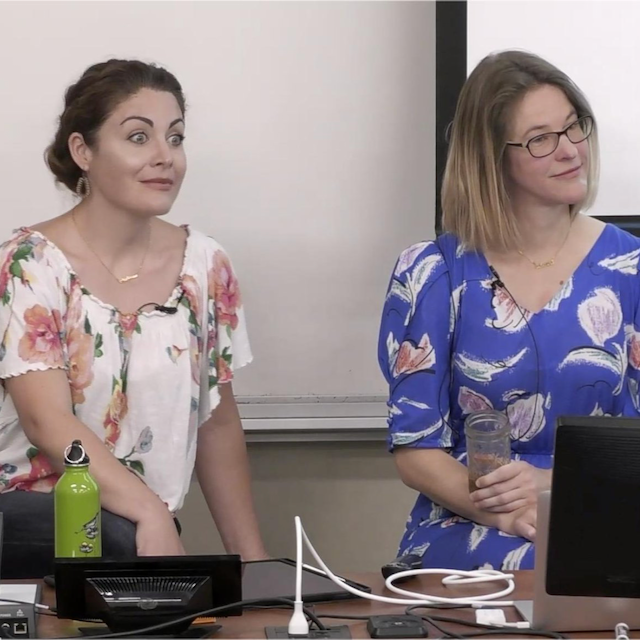Collaborative Conversational Classrooms
Do you ever co-teach with your colleagues? As in sharing the stage, not only splitting the workload? Here's a little story that illustrates how much more engaging class can be when professors teach collaboratively and facilitate conversation.

This week, Titus Brown and I were guest lecturers in Rebecca Calisi’s new undergrad course this Spring, “Biological Science for Social Justice”. Becca invited about a dozen colleagues to join her in the classroom for a podcast-style class. Her prompt was: “Over a cup of coffee, we’ll have a nice, casual chat about who you are, what you do, and why you do it. I especially want to explore with you the many ways your work and/or work in your field can help society and support social justice. Bonus points if you are able to provide an article for students to read beforehand”.
Thx @phylogenomics 4 speaking w/ my #Sci4SocialJustice class on how poop research can support #equity in #publichealth & how making #citizenscience more inclusive/accessible can serve marginalized groups!
— Dr Rebecca Calisi Rodriguez (@BeccaCalisi) April 23, 2019
PS -Shout out to @PHDcomics 4 #Microbiome video!https://t.co/HhXcSmzxY0 pic.twitter.com/24qvmzbGu9
Titus Brown and I both agreed to participate. Becca saw the similarity in our topics (genomics and data science), so she scheduled us side-by-side in the syllabus. Up until the day of Titus’ lecture, he and I worked separately to prepare for our lectures. But, at the last minute, I decided to sit at the back of the class during his lecture so that I could build on previous discussions. In addition to assigning a paper to read, Titus made a five-slide presentation with some background information or links to Sli.do, a platform that would allow every student to respond to specific questions. Over the course of an hour, Titus responded to dozens of insightful comments and questions from students. A few students spoke aloud, but many more wrote comments anonymously online.
Thx @ctitusbrown! 4 speaking w/ my #Sci4SocialJustice class about about how technological advances and #diversity in #DataScience #Genomics #Bioinformatics can help us combat social injustice at an institutional level. #KnowledgeIsPower pic.twitter.com/TMQOfU2EMb
— Dr Rebecca Calisi Rodriguez (@BeccaCalisi) May 2, 2019
For my lecture, I co-opted the use of Sli.do for moderating a discussion around three specific questions. I received about 20 written responses and at least five verbal responses to each question out of a ~60 person class. I think that’s pretty good. I also provided a pre- and post-class question for Canvas; I haven’t seen the results, but we could calculate participation.
Becca has been hesitant to let Titus use slides and Sli.do because she was aiming for more of a novel, emergent learning and conversational environment, as opposed to a scripted one. But, participation in discussions had been low, so she was willing to let us try. Now that she has seen it used effectively, she’s eager to try incorporating it more often.
Thank you @raynamharris for speaking with my #Sci4SocialJustice course about the importance of #reproducibility! And democratizing #DataScience to make data accessibility more equitable! Your Q&A session yielded some surprising answers! (I think we're responding to one here LOL!) pic.twitter.com/af4TBHB9yV
— Dr Rebecca Calisi Rodriguez (@BeccaCalisi) May 2, 2019
After class, I started wondering, when did I learn how to moderate online conversations in the classroom? I think the most pronounced memory I have of this kind of teaching was in 2015 when I was co-teaching a Carpentries Instructor Training workshop with Greg Wilson. We both used an Etherpad during class and would ask all learners to write their answers in the collaborative document. It was my first time experimenting with this teaching style, and I was very impressed by how easily Greg fielded questions from students and kept everyone on point. I’ve been using this strategy ever since as part of workshops targeted for graduate students and professionals, but this might be the first time I’ve done it in an undergraduate classroom.
By coincidence, this week I was also taking in RStudio’s Instructor workshop program with Greg. This was immediately useful because I applied every practical activity discussed in my class. I drew a concept map that illustrated the main points and the relationships between. Then I turned the concept map into an animated slide deck with ~6 slides. For me, having a concept map was really important for fleshing out the key points of my lesson and decided what to cover or not. The concept map helped me form the questions that I needed for student engagement and assessment.
I hope to see more and more professors co-teaching together. The Carpentries Instructor Training program is where I first learned about this and other strategies for creating better learning environments. I hope more people I know continue to be versed in these practices so that I can do more and more of my teaching in collaborative and conversational classrooms.